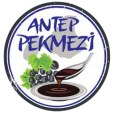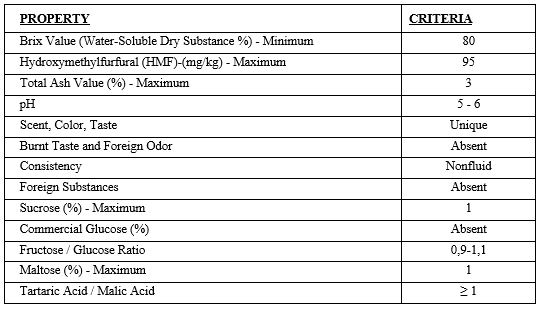Antep Pekmez Protected Geographical Indication
Thursday, July 7, 2022
No: 509 – Protected Geographical Indication (PGI)
ANTEP PEKMEZ / GAZİANTEP PEKMEZ
Registrant
GAZIANTEP COMMODITY EXCHANGE
This geographical indication was registered on 24.07.2020 to be protected as of 20.07.2017 under the Industrial Property Law No. 6769.
Registration Number : 509
Registration Date : 24.07.2020
Application Number : C2017/061
Application Date : 20.07.2017
Name of Geographical Indication : Antep Pekmez / Gaziantep Pekmez
Product / Product Group : Pekmez / Processed and unprocessed vegetables and mushrooms
Type of Geographical Indication : Protected Geographical Indication (PGI)
Registrant : Gaziantep Commodity Exchange
Address of Registrant : Sanayi Mahallesi 60092 Nolu Sk. No:15 Şehitkamil GAZİANTEP
Geographical Boundary : Gaziantep province
Usage Format : The phrase Antep Pekmez / Gaziantep Pekmez and the geographical indication
emblem are placed on the product itself or on its packaging. When it cannot be
used on the product itself or on its packaging, the phrase Antep Pekmez / Gaziantep
Pekmez and the geographical indication emblem are kept in the business in such a
way that it can be easily seen.

Product Description and Distinctive Features:
It is a local solid grape molasses in paste consistency and amber color produced in Gaziantep. Pekmez, which can be spread on bread and eaten, can also be melted and consumed in syrup form. The phrase “You go to Antep, you eat pekmez.” proves that Antep Pekmez / Gaziantep Pekmez is one of the first products that come to mind when Gaziantep is mentioned.


Antep Pekmez / Gaziantep Pekmez is made from Dökülgen grapes. It is first produced from grapes in liquid consistency. What makes Antep Pekmez / Gaziantep Pekmez special is the solidification of the liquid pekmez.
Some Physical And Chemical Properties of Antep Pekmez / Gaziantep Pekmez

Production Method:
The Traditional Method:
Antep Pekmez / Gaziantep Pekmez can be made from both fresh and dried grapes. Producing pekmez from dried grapes as well as fresh grapes ensures that production can be carried out for the entirety of one year. Making pekmez from dried grapes starts from process number 4 of the pekmez production processes described below. From boiling onwards, the process is the same.
- “Tah”ing
First, the grapes are “tah”ed, meaning the good ones are separated from the bad, spoiled, rotten ones. Then, the grapes in plastic crates are dipped in water and taken out, and washed. Thus, it is largely free from foreign materials such as dust and pesticide residues. Moreover, the microorganism load is decreased.
- Placing on Raft and Dredging with Soil
After that, the grapes are rinsed. They are then placed in strainers made of stainless steel and the water is filtered out. Then, they are placed on a wooden raft. A grape raft is a rectangular pool-shaped structure made of wood, monolith or, more recently, concrete, by which the grapes will be crushed and juiced. The grapes in question are first extracted from foreign materials. In addition, some soft, browned grapes found in bunches of grapes are called tähi (tah) grapes in Gaziantep dialect, and are also extracted and used to make “täh (tah) pekmez” or “täh (tah) sherbet” later.
The grapes, which are sorted and picked, are washed and put down into rafts. After the grapes are placed on the raft, marl soil (pekmez soil) is sprinkled. White soil, also called şire soil, is the fragmented form of keymık stone. A person called "fartçı", who has on clean, washed boots, begins to trample the grapes. This operation should be done duly and carefully. The grape juice that exudes first is taken into containers from the upper part of the raft. This is a clearer and lighter colored juice and is called "nasal water". It is not used while making Antep Pekmez / Gaziantep Pekmez.
- Trampling
The person who performs this operation is called a trampler / fartçı. This person must do this work properly and use their feet carefully and systematically. For this, the steps must be light and side by side. If the trampling is done correctly, the grape skins form a layer at the bottom of the raft. When trampling starts, a mixture of sherbet and soil starts to flow into the container placed below from the part of the raft resembling a faucet. An appropriate strainer is placed beforehand. If it has tah, it is filtered. As the grapes are trampled on, they get stuck down and go down from the upper hole level. After the grape juice flow from the hole at the bottom stops, the crushed grapes are placed in the grape press.
- Placing into Grape Press
The press is an open top and bottom cylinder with iron bars around it, placed on a thick wooden stand and around a screw threaded mill. Grapes, which are thoroughly crushed and dehydrated on the raft, are placed along with their stems into a cylinder with iron bars. With the unique mechanism of the press, the grapes in the cylinder with iron bars are pressed. Meanwhile, the juices of the grapes squeezed in the press start to be collected in the container below.
- Placing and Boiling Process in Mahsere
When the container is full, the sherbet is drained and transferred to the cauldron called mahsere on the stove. The mahsere is placed on the stove with the soil mixture.
It is ensured that the temperature of the stove is 115-120 °C. This process ensures that the juice becomes transparent when slackened. The hot sherbet is checked after being taken into a bowl with a handle and adding some water (about 200 ml). If the consistency is appropriate, the boiling process is completed.
During boiling, the flowers of cypress spurge (Euphorbia cyparissia) and the above-ground parts of St. John's Wort (Hypericum perforatum), which grows naturally in the region, can be added into the mahsere. A pinch of Phacelia tanacetifolia Bentham, approximately 150-200 g., is also put in the mahsere during boiling for flavor.
When the cooking process starts, scum called “kef” form on the surface of the juice. The scum should be taken with wide ladles to get a clear pekmez appearance. The juice, which has been rid of its kef, is left to boil for a while to get a higher viscosity. Even though foaming occurs on the surface of the juice during this period, this is only a temporary foaming caused by boiling and not in the character of kef. During this period, the pekmez should be stirred continuously so that it does not caramelize too much.
The soil and mixed dark colored foams accumulated on the grape juice that is now boiling are removed with the help of a large strainer or colander to ensure that the juice is clear and bright. In this way, it is boiled for 1-2 hours until the foam is gone. The fire under the boiling grape juice is reduced as much as possible. Hot grape juice is taken into smaller containers and basins with ladles called “handled bowls”. Boiled grape juice, which could not be taken with a handled bowl, is taken with unique juice shovels. The juice shovel is a tool similar to regular shovels made of half-covered galvanized sheet. Cold water (200-250 ml) is sprinkled onto the hot grape juice divided into containers. It is rested in an appropriate place for 1-2 hours. In this way, the elements that cause astringency, that is, sourness, begin to settle to the bottom of the basins and other containers, along with the soil. The grape juice, which is left to rest for about 30-45 minutes, is poured back into the cleaned mahsere cauldron. In the meantime, it should be moved very slowly so that the sediment at the bottom of the basins does not mix with the grape juice again. This process is called "tortlama" or "tortulama" (dregging) in Gaziantep. After dregging, the sediment remaining at the bottom of the basins is dumped into tightly woven bags with cornelian cherry leaves at the bottom, and the grape juice is filtered. This juice is also called "damla (drop) sherbet".
- Transferring the Boiled Sherbet to Copper Cauldrons
In order to wash the cauldron and to remove the soil from the grape juice, the boiled sherbet is poured into tinned copper pots. Meanwhile, the soil sinks to the bottom. The sherbet now has a color close to lemon yellow.
Then they are covered and rested for 1-2 days. The yeast is prepared. The yeast for Antep Pekmez / Gaziantep Pekmez is made from old solid grape pekmez a year ago. In a large bowl, an average of 100 kg of fresh liquid grape pekmez is mixed with 4-10 kg of old solid grape pekmez. After it is thoroughly crushed, 1/3 of fresh liquid grape pekmez is added on it and mixed thoroughly. When the container is full, it is poured onto the fresh pekmez in the tub and mixed thoroughly with a wooden shovel. The fermented pekmez is placed into wooden or tin cans. In these cans, pekmez solidifies within 1-2 days. Its viscosity may be increased also by adding gypsum extract to the solid pekmez in the wooden cans.
The Modern Method:
In the modern method, in the production of Antep Pekmez / Gaziantep Pekmez, dried grapes are first rehydrated and passed through a grinder. The extraction process is applied to the minced grapes according to the counter-current extraction principle.
If pekmez is to be obtained from fresh grapes, the cleaned grapes are separated from their stems by passing through a stem separator, granulated and crushed by passing through a grape crushing mill. In order to obtain the juice, the grapes are pressed and passed through a separator to separate them and their coarse materials. After the separation process, marl soil or calcium carbonate (CaCO3) is added to eliminate acidity. The grape juice is heated up to 70˚C in order to allow the soil to affect the juice easily and quickly, to prevent the activity of yeasts and to accelerate the clarification. Clarification is necessary in order to clarify the wort and to remove the bitter taste. After rinsing, the wort is concentrated by vacuum to reach the desired water-soluble dry matter value. Then, 4 kg of solid grape pekmez made in the previous year and 100 kg of liquid fresh grape pekmez are mixed. 500 grams of soapwort extract is added to the mixture. The mixing process is carried out between 10-15 minutes by using mixers that are able to both whisk and grind. The fermented pekmez is divided into wooden or tin cans. The obtained pekmez solidifies in these cans within 1 to 2 days. If you want the pekmez to have a stiffer consistency, soapwort extract can be added to the solid pekmez being placed in its package.
The Production, Processing and Other Transactions to be Performed within the Geographical Boundary:
Antep Pekmez / Gaziantep Pekmez production requires Dökülgen grapes. All of the production stages should be carried out in the Gaziantep province.
Inspection:
The supervision authority consists of at least 3 experts from Gaziantep Commodity Exchange, Gaziantep Provincial Directorate of Agriculture and Forestry, Gaziantep Gastronomy and Tourism Association, Gaziantep Chamber of Restaurants, Kebab Shops, Pastry Shops, Pastry Shops and Baklava Shops, Gaziantep University Fine Arts Faculty Gastronomy and Culinary Arts Department under the coordination of Gaziantep Commodity Exchange.
The supervisory authority
- Checks whether the production of Antep Pekmez / Gaziantep Pekmez is made in accordance with the specifications explained in the production method.
- Ensures that inspections are carried out once a year or when deemed necessary or in case of complaints.
- Inspects whether Dökülgen grapes are used in the production of Antep Pekmez / Gaziantep Pekmez.
- Examines the color, taste and odor of Antep Pekmez / Gaziantep Pekmez.
The supervisory authority may benefit from or purchase services of public or private institutions, or natural or private entities in charge, during the execution of the inspection. The registrant carries out the legal processes for the protection of rights.

Original text from ci.gov.tr.












